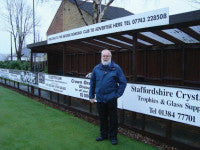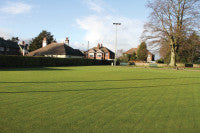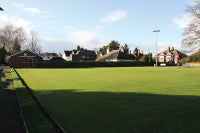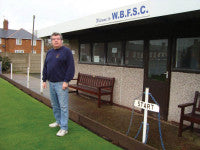Seeking perfection on the bowling green
 When it comes to 'The Green', Crown Green Bowlers are a notoriously difficult group to please - ask one hundred bowlers for an opinion and you will almost certainly receive one hundred different responses. So, how does the bowls greenkeeper attempt to meet the expectations of the club membership? In fact, how does he even know what those expectations are?
When it comes to 'The Green', Crown Green Bowlers are a notoriously difficult group to please - ask one hundred bowlers for an opinion and you will almost certainly receive one hundred different responses. So, how does the bowls greenkeeper attempt to meet the expectations of the club membership? In fact, how does he even know what those expectations are?
Mark Allen, of Amenity Land Solutions, seeks out the answers from two of the best bowls greenkeepers in the Birmingham area
My first position of responsibility within turfcare came in the early 1990s. As a keen Crown Green bowler with a leading Birmingham club, my long summer university vacation provided the seasonal free time to help out as an unpaid 'grass cutter'.
Despite a thirst for knowledge, it was difficult to find any information at all on bowls greenkeeping P.I. (pre-internet). My education was derived from golf-based literature, the odd friendly salesman (yes, odd and friendly in that order!) and some rather questionable bowls green folk-law. Notwithstanding the clubs position at the pinnacle of the Midlands bowls scene, a clutch of County players within the ranks and a regular venue for cup finals and inter-county matches, the maintenance of the green was entrusted to a nineteen year old novice - a 'willing soldier', but lacking anything resembling 'experience'. I now realise that a willing soldier is usually the best that most bowls clubs can hope to attract - anything resembling experience is a bonus.
At that time, when it came to the bowling green, the mentality of the membership was very much one of 'shave it short and make it fly' - which was okay, up to a point. However, that point was reached in the drought year of 1995, when we shaved it short and watched it die!
So followed a couple of years of hard work, mixed in with a fair amount of luck (how we all need that) but, most importantly, a genuine interest in the subject. Eventually, a surface was produced that we could all be proud of, given the minimal kit and meagre budget ... and we were one of the better-off clubs! My overriding memory of that era was trying to convince the membership that the green didn't need to turn yellow to be a 'good home green'.
The situation today is much better - certainly the majority of top flight clubs in the Warwickshire and Worcestershire County Bowling Association (Greater Birmingham's largest bowls league) have excellent playing surfaces, and the 'cut it short' mentality has been replaced with a far more enlightened approach.
Knowing many of the bowls guys well, I recently took the opportunity to catch up with a couple of them, to get their views on managing not only their greens but also the expectations of their membership.
 My first call was to the much-admired George Bowling Club at Warley. Straddling on the Birmingham /Black country border, 'The G-men' have been the Midlands team to beat for at least the last twenty years. The man charged with giving them a surface to match their reputation, Eric Winstone, cuts a formidable figure around the club. A former Warwick & Worcester County player, Eric has strong views on greenkeeeping, and certainly 'does it his way' as far as decision-making is concerned.
My first call was to the much-admired George Bowling Club at Warley. Straddling on the Birmingham /Black country border, 'The G-men' have been the Midlands team to beat for at least the last twenty years. The man charged with giving them a surface to match their reputation, Eric Winstone, cuts a formidable figure around the club. A former Warwick & Worcester County player, Eric has strong views on greenkeeeping, and certainly 'does it his way' as far as decision-making is concerned.
I asked Eric, what the members of 'The George' expect from their home green? "Pace," he replied, "Our lads want quick pace downhill and a significant weight difference going back the other way."
To briefly explain the rudiments of a 'crown green', in contrast to a 'level green', its contours can take any form. Whilst a 'true' crown green would have a convex crown in the centre, and equally graded sloping sides to each edge, the reality is that a 'true' crown green almost certainly does not exist. What do exist are many hundreds of greens all completely different in shape, size and topography. You will understand, in this context, that 'home advantage' is everything, as the 'home-ster' will know where to 'attack' the jack (uphill) and where to play for 'run' (downhill).
"It's the weight differences that win us games," continues Eric. "Often the weight difference can be four yards slower going up the hill - that's what catches the visitors out."
So, that means that all home bowlers like the green to be very quick, I presume? "No, not at all," Eric explains. "If the green is too quick, too freakish playing down the slopes, then we lose the advantage that a pronounced weight difference provides."
 Not too quick, but not too slow! So, 'consistency' is what the top players at the top club expect? " Yes, and whilst achieving consistency is a difficult part of the greenkeeper's art, it is more achievable these days with an improved standard of equipment at our disposal. The evolution of our store shed inside ten years has seen us go from owning just an old mower and a cyclone spreader, to now running a full irrigation system, a maintenance programme built around the Dennis F510 cassette machine and end of season renovations that, in the last few years, have involved golf course standard equipment, such as the Verti-drain and the Graden machines."
Not too quick, but not too slow! So, 'consistency' is what the top players at the top club expect? " Yes, and whilst achieving consistency is a difficult part of the greenkeeper's art, it is more achievable these days with an improved standard of equipment at our disposal. The evolution of our store shed inside ten years has seen us go from owning just an old mower and a cyclone spreader, to now running a full irrigation system, a maintenance programme built around the Dennis F510 cassette machine and end of season renovations that, in the last few years, have involved golf course standard equipment, such as the Verti-drain and the Graden machines."
Eric's policy of never cutting below 5mm, a fortnightly rotational regime of verticutting, pencil tining through the playing season and the ability to apply water evenly and to a decent depth, means that 'The George' are now achieving a surface that even many a golf club would be proud of.
Whilst an end of season Masters competition delays the timing of Eric's autumn renovations, both he and the membership acknowledge that the income is vital in order to keep the club solvent. The competition attracts bowlers from all over the country, so the pressure is on to make their 'road trip' an enjoyable one. Interestingly, the expectations of the visiting bowler are usually quite different from that of the home members.
"Competition bowlers just want a true surface, a fair green and good facilities when they arrive. Pace is not such an issue and, certainly, it is almost unheard of for a losing player to blame his defeat on the speed of the bowling green."
This gives a revealing insight into the whole subject of 'bowlers expectations'. In my experience, winning players rarely complain that the green was not to their liking on the day of a victory. Losing players on the other hand ... now that's anther story.
 Perhaps, bowlers need to be more honest about their own performance or, perhaps, more realistic about their own ability, as it's easy to blame outside influences on poor results. I'm aware that we are now straying into areas marked 'human nature' and, as I'm no Sigmund Freud, I'll leave it there!
Perhaps, bowlers need to be more honest about their own performance or, perhaps, more realistic about their own ability, as it's easy to blame outside influences on poor results. I'm aware that we are now straying into areas marked 'human nature' and, as I'm no Sigmund Freud, I'll leave it there!
Having known Eric for a long time, I'm always impressed by his interest in turf culture, and his willingness to explore new technologies. Last season, for example, he trialled the growth regulator 'PrimoMaxx' with fantastic results.
"In terms of thickening the sward and reducing the sheer volume of grass clippings, PrimoMaxx worked very well - I'd say reducing the amount of grass removed per cut from two boxes to around half a box. The affordability of a product like this means that we can achieve results today that we could only dream about back in the 1970s, when I first became interested in bowling greens."
Along with PrimoMaxx, regular applications of wetting agent are another relatively new development in 'crown green land'. Eric likes to mix and match the best of these new technologies with the overriding basic principles of soil science that have stood the test of time.
"Ultimately, without the green, there is no club. We've lost too many greens over the last few years to be complacent, so my view is let's give this thing every help we can."
 I leave Eric (well he throws me out because he's got work to do - "can't stand here chatting to you all day"), and head a few miles down the road to West Bromwich to catch up with another star of the Crown green maintenance fraternity, Alan Bentley.
I leave Eric (well he throws me out because he's got work to do - "can't stand here chatting to you all day"), and head a few miles down the road to West Bromwich to catch up with another star of the Crown green maintenance fraternity, Alan Bentley.
Well known to bowlers nationally - largely for his organisation of the annual 'West Bromwich Football Supporters Bowling Club Open' - Alan wears several of the 'important hats' within his club and, to many people, he is 'Mr West Brom'.
As a bowler, Alan is up there with the best of them (several Warwick & Worcester County caps bear testament to this) and, latterly as a greenkeeper, Alan's attention to detail and perfectionist nature is proving a big hit with the membership.
Whilst Eric at 'The George' has an end of season tournament to contend with, Alan has the opposite situation - a pre-season event. Since 1978, 'The West Brom' Open has attracted entrants from far and wide and, whilst most greenkeepers are still dusting off their mowers and beginning to think about the new season, Alan is in 'full-on' maintenance mode by the end of February.
Each weekend throughout March, West Brom play host to sixty-four players, each competing in up to three qualifying games to reach a grand finals day. That's a lot of foot traffic at a difficult time of year for the turf, yet Alan's green never fails to meet bowler's expectations. So, just how does he do it?
"We've got a good sub-structure," says Alan, "even though the green is approaching one hundred years old. The soil is quite light and free draining, so moving moisture through the profile is rarely a problem. Given that a dry soil warms up quicker than a wet one, the make up of the green tends to ensure that the grass copes well with whatever the winter has thrown at it."
When asked why greens have improved so much in the last decade, Alan is quick to cite affordability of good equipment as the overriding factor. "Installing irrigation was an 'overnight improvement' to the way the green could be managed. Take away the potential nightmare of severe drought stress and, suddenly, we knew the green would only ever continue to improve from then on. Prior to this, lots of hard work could be easily wiped out in a hot spell."
With Alan's tenacity, money was obtained to fund the irrigation system from charitable sources. This meant that the club could also use any remaining cash to finance other capital purchases, such as a Protea 510 Groomer/Dethatcher.
"It's a been a brilliant machine for us - the most useful in the shed, except for the mower, obviously - and very much within the price range of many small clubs like ours. I like to use the verticut at least once a fortnight during the playing season."
On the subject of 'expectation', I ask Alan exactly what his members are anticipating when they step onto his green? "Perfection," he replies, without hesitation "and the better it is, the better they expect it!"
No pressure there then! So, how do you attempt to meet that expectation? "I liaise with the team captain, taking the view that the members have elected him so, if I can work with that captain, hopefully the members will understand what we are all trying to achieve."
"To a degree, expectation from home players increases the more regularly they are playing competitive matches on there. Often, our bowlers will play an away match on a green in less than perfect condition, and not make much of a fuss about it. However, if their home green is not playing just exactly as they think it should the following week, they can be quite quick to voice their displeasure! Maybe it's a case of familiarity breeding contempt."
Regarding his end of season work, Alan sees it as doubly important to "start early and do it well", given the timing and profile of the open competition so early at the start of the following year.
September 2011 saw the club solid tine, Graden, overseed, topdress and feed. Alan is keen to acknowledge his small team of helpers. "It's not all just me!" he emphasises. "I get good help, not only in the autumn but year round, with daily winter dragbrushing and mowing through the growing season."
That last point is one worth emphasising, as successful bowls green maintenance needs to be viewed as a year round occupation. The better greens are the ones that receive as much attention on December 1st as they do on April 1st - and Alan and Eric's greens fit very much into this category.
"The days of putting the mower to bed in September and getting it out in March are now a distant memory," smiles Alan.
We close our conversation with a nod to the past as Alan suggests, "we criticise our predecessors for cutting greens too short and giving very little thought to matters such as aeration yet, in truth, it was 'Hobson's choice' back then. The only way to achieve a semblance of consistency was to shave a green on a regular basis. Hampered by a lack of money, equipment and education, greenkeepers probably did as much as they could, and bowlers got what they got. I'm sure expectation back then was much less of an issue."
Looking to the future of his own green, Alan is keen to continue upgrading both the quality and quantity of the clubs equipment. "We've just managed to obtain a decent second-hand aerator, which is really the last piece in the jigsaw. That said, give me a blank cheque book and I'd happily add a new mower and a dedicated scarifier to the inventory!"
As I conclude my quest to throw some light on bowler's expectations, it's clear that, despite whatever expectation might be, reality dictates, "you get what you pay for". Maybe the expectations of the average bowling club membership should extend no further than the budget. As a bowler myself, I've always been curious why members are so reluctant to put their hands in their pockets, in comparison to, say, golf. Bowls has always been a sport supplied on the cheap with greens to prove it! Probably the greatest skill that guys like Alan and Eric possess is to turn a 'Vauxhall' budget into a 'Rolls Royce' surface.
Ultimately, the whole question of a bowler's expectation relates very little to anything tangible, and very much to the human psyche. Expectation is really just another word for opinion and, like backsides, everybody has got one!
Whilst bowlers might say they want 'consistency' from greens, I've a hunch that removing the element of the ever-changing green - influenced primarily by the weather and secondly by the greenkeeper - would remove the very essence of the game. The heart and soul of our sport is playing outdoors and adapting to a constantly changing situation. Now, who wouldn't want to be involved in a game like that? Err, indoor bowlers I guess!
